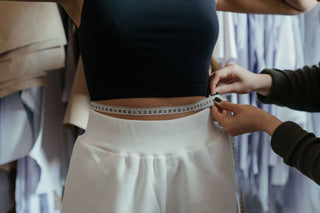In the world of vintage fashion, achieving the perfect fit is key to feeling confident and comfortable in your clothing choices. Whether you're shopping online or in store, understanding your body measurements is the cornerstone of a successful shopping experience. In this blog post, we'll walk you through the most crucial measurements you need to know to ensure a flawless fit every time.
MEASURING TIPS
- Use a flexible measuring tape
- Another person can be helpful with the trickier measurements
- Hold the measuring tape taught, not tight - it should be snug but should not indent your skin or feel uncomfortable or constricting
- Round to the nearest whole number
- Conventional sizing uses even numbers. If you have an odd number measurement, pull the measuring tape between the lower and higher measurement on your body to determine what would be more comfortable
Bust Measurement: The first step is to measure your bust (also called the "chest" or "full bust" measurement). Place the tape measure around the fullest part of your chest, ensuring it's snug but not tight. Take a deep breath in and out to make sure it is not too constrictive.
Waist Measurement: Next, move down to your waist, the center point between your rib cage and hip bone. On some body types, this is the smallest part of the torso, just above your belly button. Wrap the tape measure around this point, maintaining a taut but comfortable fit. Try sitting down and standing up with the tape in place to make sure it is comfortable and not too restrictive.
Hip Measurement: Measuring your hips correctly is crucial, especially for bottoms and fitted dresses. With your feet together, find the largest area below your waist and wrap the tape measure around it. Ensure the tape measure is parallel to the ground and not too high or low.
Shoulder Measurement: To measure your shoulders, hold one end of the measuring tape at the outside of your shoulder, the point where your shoulder bone meets the top of your arm. This is generally where the highest point of your shoulder begins. Pull the tape across your back in a straight line to the opposite shoulder. This will give you an accurate shoulder measurement that falls typically between 15 and 18 inches.
Arm Measurement: Place your arm by your side, and one end of the tape measure at the point where your arm meets your shoulder. Bring the tape measure down your arm in a straight line to the top of your wrist bone.
Shoulder-to-Waist Measurement: Understanding the length of your torso is essential, especially when purchasing garments with defined waistlines. Measure from the center of the top of your shoulder straight down to your waist.
Under Bust Measurement: An important but often missed measurement is the under bust. This is helpful especially when looking for umpire waist garments and lingerie. This measurement is taken around your rib cage, directly below your chest.
High Hip Measurement: The high hip can be very helpful when trying to fit lower rise pant and skirt styles. This measurement is taken between the top of your hipbone and the fullest part of your hip.
Armed with your accurate measurements, you can easily decipher size charts and confidently shop for vintage that fits like a dream. This knowledge will be your invaluable tool for making the right choices when shopping online, and vintage sellers should always be happy to provide you with more detailed measurements to help you assess fit. So take a moment to jot down your measurements, and you'll be well on your way to building a wardrobe that suits your unique body shape and style preferences.
Shopping for vintage clothes should be an enjoyable experience, and with our guide to body measurements, you're well on your way to achieving the perfect fit every time.

